Chinese Dynasty: Southern Song - A Flourishing Tapestry of Culture and Progress
The Southern Song Dynasty (南宋, Nán Sòng), which spanned from 1127 to 1279, was a period of remarkable transformation and cultural efflorescence in Chinese history. Following the fall of the Northern Song Dynasty (北宋) to the Jurchen Jin (金, Jīn), the Southern Song Dynasty established its capital in Lin'an (临安, modern-day Hangzhou, 杭州). Despite facing constant threats from Jin and later the Mongol Empire, the Southern Song Dynasty managed to achieve significant advancements in various spheres, including politics, economics, technology, and culture.
Politics
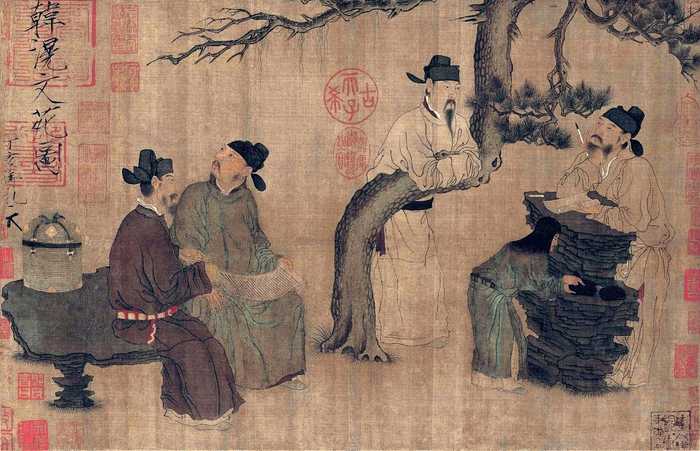
A Literary Garden, by Zhou Wenju, Song Dynasty
The Southern Song Dynasty continued the "strong central authority and weak local power" (强干弱枝) policy from the Northern Song Dynasty. They strengthened centralization in various aspects including central and local power, bureaucratic institutions, judiciary, and military authority to maintain internal unity, social stability, and economic development.
In terms of the appointment system, Southern Song inherited the era of "the emperor and the scholar-officials co-governing" (皇帝与士大夫共治天下) from Northern Song. During the Southern Song period, the selection of officials was not restricted by social status. Anyone, as long as they were not serious criminals, could take the imperial examination and be appointed officials. The majority of successful candidates in the Southern Song's imperial examinations were commoners.
The period of both the Northern and Southern Song Dynasties is considered the most lenient in terms of feudal society's ideological and cultural environment, objectively playing a positive role in promoting economic, social, and cultural development.
Economy
During the period of the Song-Jin standoff, the economy in the southern regions notably outpaced that of the north. In the early Southern Song, although the Jin forces launched multiple incursions southward, they rarely managed to cross the Yangtze River, resulting in comparatively less disruption in the southern regions. A significant number of northern Song people were unwilling to live under Jin rule, leading to a migration to the south and a substantial increase in the southern population.
The Song Dynasty established a policy of emphasizing both agriculture and commerce. They implemented measures like benevolent policies towards merchants, leading various social strata to engage in commercial activities. This brought about a revolutionary transformation in the commercial economy, with commerce being regarded on par with agriculture as a source of societal wealth. The belief that "scholars, farmers, artisans, and merchants are all the foundation of the people" (士农工商皆百姓之本业) became a societal consensus, elevating the social status of Song merchants to unprecedented levels.
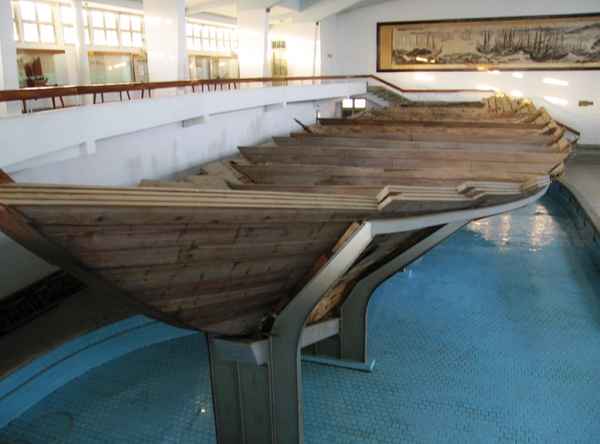
Song Dynasty Ancient Ship of Quanzhou Bay
The Southern Song Dynasty and the Abbasid Caliphate (阿拉伯帝国) on the northern coast of the Indian Ocean constituted the two major hubs of the global trade network at the time.
Rice paddies increased during the Southern Song, further boosting agricultural yields. Regions in the Lake Tai (太湖) basin, such as Suzhou (苏州) and Huzhou (湖州), produced a substantial amount of rice. Cotton cultivation expanded to the Yangtze River and Huai River (淮河) basins and cotton textile production became a primary rural sideline industry in cotton-producing areas.
The Southern Song's ships were equipped with compasses and possessed strong wind resistance. The main ports for overseas trade were Quanzhou (泉州), Guangzhou (广州), and Mingzhou (明州), engaging in trade with Japan and Korea to the east and reaching African countries to the west.
The influence of the Southern Song Dynasty on China's subsequent historical development was immense. It initiated the process of popularization in Chinese society and exhibited certain characteristics akin to the eve of modern Europe, such as the rise of major cities, the formation of a citizenry class (市民阶层), and the prosperity of the commercial economy.
Many scholars refer to the Song Dynasty as the "early modern period" of China. During Southern Song, the national economic center completed a historically significant shift from the Yellow River basin to the Yangtze River basin, marking a pivotal turning point in the development of Chinese society.
Science and Technology
The technological achievements of Southern Song placed it at the forefront in various fields and exerted a significant influence on China's technological development.

Left to right: Huang Shang's Tianwen Tu; a 12th-century Chinese flamethrower; Yang Hui's triangle.
Compass
After its invention, the compass was swiftly applied to maritime navigation. The earliest records of compass use date back to the late Northern Song. During the Southern Song, the compass gradually supplanted celestial navigation, becoming the primary method of maritime navigation.
In the 13th century, the compass spread to various Arab and European countries, playing a monumental role in global economic and cultural exchange and development.
Gunpowder
The use of gunpowder in military applications began in the late Tang. The Northern Song government established specialized institutions in the capital, where gunpowder and firearms were manufactured. During Southern Song, the tubular firearm known as the "fire lance" (突火枪) was invented. This marked a new phase in human military history.
In the mid-13th century, gunpowder and firearms were introduced to the Arab world and later reached Europe.
Printing
The printing industry, which had already developed in Northern Song, became even more advanced during the Southern Song Dynasty.
Song's reliance on the imperial examination system for selecting officials, along with the establishment of schools and the widespread circulation of books, created a pressing need for printed materials. The flourishing printing industry also provided the material conditions for academic development. Both government officials and private bookstores in Southern Song engaged in woodblock printing (雕版印刷), resulting in a wide dissemination of printed books.
Astronomy
The observation of astronomical phenomena by the Southern Song court built upon the foundation established during the Tang Dynasty, achieving new progress and development.
The Southern Song astronomer Yang Zhongfu (杨忠辅) oversaw the creation of the Tongtian Calendar (《统天历》), the first calendar based on systematic and precise astronomical measurements. This calendar used a relatively precise value for the length of the tropical year, 365.2425 days, differing from the actual length by only 26 seconds, a precision comparable to the Gregorian calendar used worldwide 400 years later. Additionally, Yang Zhongfu discovered that the length of the tropical year was not constant but gradually reduced over time.
The Tianwen Tu (《天文图》, "Celestial Chart") by the Southern Song astronomer Huang Shang (黄裳) is the earliest surviving celestial chart with twenty-eight constellations, holding significant scientific value in the history of astronomy.
Mathematics
The Southern Song Dynasty made substantial contributions to the field of mathematics.
The remarkable mathematician Qin Jiushao's (秦九韶) work Mathematical Treatise in Nine Sections (《数学九章》) introduced the "method of positive and negative square roots" (正负开方术), which closely resembled modern techniques for finding positive roots and predating Western methods by over 500 years.
Another outstanding mathematician, Yang Hui (杨辉), authored over ten mathematical works including Detailed Explanation of the Nine Chapters on the Mathematical Art (《详解九章算法》). In this book, Yang Hui drew a triangular diagram representing coefficients after binomial expansion, known as the famous Yang Hui's Triangle (杨辉三角). It was the same as Pascal's Triangle, discovered by Yang's predecessor Jia Xian (贾宪). In addition, Yang Hui's discussions on series summation made him one of the earliest researchers of high-order arithmetic progressions in the world, following Shen Kuo (沈括).
Medicine
Southern Song also achieved notable progress in medicine.
The formalization of forensic medicine took shape during this period, with Song Ci's (宋慈) Collected Cases of Injustice Rectified (《洗冤集录》) being the world's first specialized treatise on forensic medicine. It preceded its Western counterparts by over 350 years, laying the foundation for ancient Chinese forensic medicine and having a broad influence on global forensic science.
In addition, Southern Song saw the emergence of numerous works in acupuncture, surgery, gynecology, pediatrics, and other medical fields, achieving remarkable accomplishments.
Culture
The Southern Song Dynasty represented the pinnacle of ancient Chinese intellectual thought and literary arts. Despite a penchant for indulgence and a lack of grand ambitions, the rich and diverse cultural life propelled Chinese culture into its most brilliant period of development.
From the latter half of the 10th century to the mid-13th century, Song Dynasty culture held a leading position globally. The fusion of Southern Song with the cultural traditions of various East Asian countries continues to exert significant influence on contemporary East Asian society in areas such as politics, economics, ideological culture, social life, and family relations.
Modern Chinese culture, it can be said, has its roots deeply embedded in the cultures of the Northern and Southern Song Dynasties.
Literature
The surviving works of Southern Song literature not only exceed those of the Northern Song period in quantity, but they also possess their own distinctive features in terms of intrinsic qualities and artistic expression.
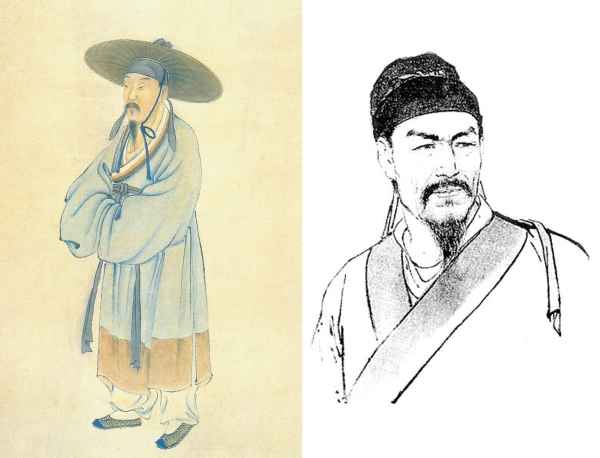
Portraits of Lu You (left) and Xin Qiji (right)
The early Southern Song period saw the threat of the Jurchen Jin forces from the north. Resultingly, a patriotic spirit of resisting ethnic oppression and upholding national unity emerged among the populace, becoming a common tendency among progressive writers. The verses (ci poems) of Zhang Yuangan (张元干), Zhang Xiaoxiang (张孝祥), and Xin Qiji (辛弃疾), the poems of Lu You (陆游) and Fan Chengda (范成大), and the prose of Chen Liang (陈亮) and Ye Shi (叶适) collectively advanced the patriotic tradition in Chinese literary history.
In the later stages of Southern Song, the scholar-official class experienced a social stratification due to the examination system, leading to the emergence of poets from various walks of life, shifting the cultural focus downwards.
With the stable standoff between Song and Jin, the call for patriotism in literature gradually weakened. In its place, emerged "wan yue" school (婉约派, literary elegance) poets like Jiang Kui (姜夔) and Shi Dazu (史达祖), and the "si ling" school (四灵诗派) with Xu Zhao (徐照), Xu Ji (徐玑), Weng Juan (翁卷), and Zhao Shixiu (赵师秀), as well as wandering poets represented by Liu Kezhuang (刘克庄). Their works held varying ideological values and artistic achievements, with some reflecting reality, but more often displaying a pessimistic attitude towards life.
As the Southern Song Dynasty approached its downfall, due to the acute ethnic conflicts, some stirring poems were produced. Among them, the national hero Wen Tianxiang (文天祥) was the most representative figure.
Painting
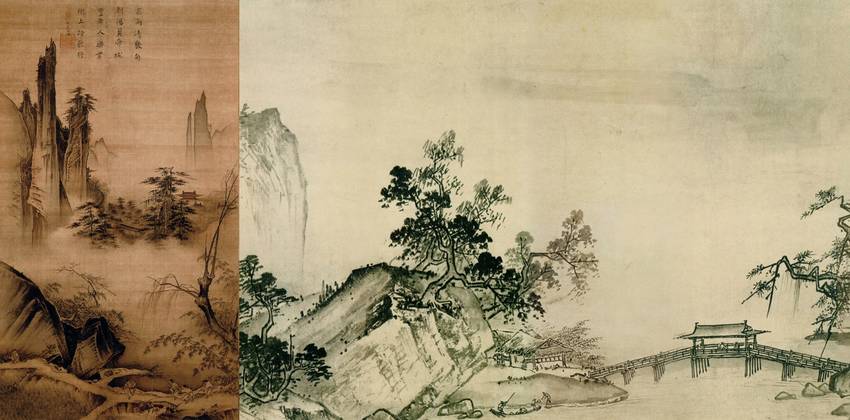
Dancing and Singing - Peasants Returning from Work by Ma Yuan (left);
A section of the Pure and Remote View of Streams and Mountains by Xia Gui (right).
The Song Dynasty was the golden age of Chinese painting. The craftsmanship, decoration, and overall effect of arts and crafts in Southern Song painting were exemplary, serving as models for subsequent artists to emulate.
During this period, artistic style was largely unaffected by foreign cultures and predominantly adhered to traditions. Landscape painting (山水画) remained a crucial category, with Ma Yuan (马远) and Xia Gui (夏圭) being notable representatives. They depicted local landscapes with misty and gentle scenes, in contrast to the rugged landscapes from the Northern Song period. This style of painting originated from the imperial painting academy of Emperor Gaozong of Song (宋高宗) and is commonly referred to as the Ma-Xia school (马夏).
The vivid and naturalistic brushwork of paintings by Buddhist monks (禅宗画) during this period also formed a strong contrast to landscape painting.
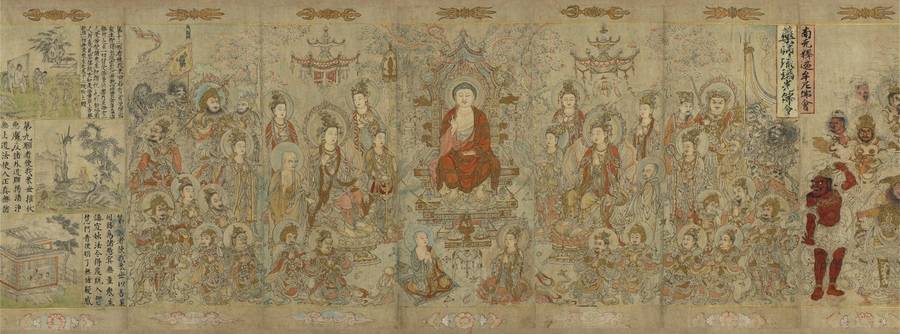
The Sakyamuni Buddha, by Zhang Shengwen (1173-1176)
Philosophy
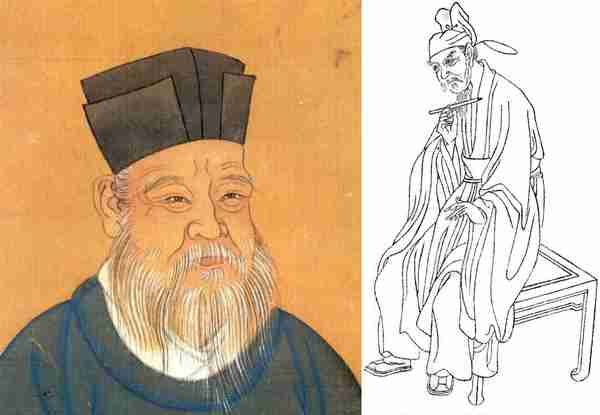
Portraits of Zhu Xi (left) and Lu Jiuyuan (right)
The Song Dynasty witnessed the flourishing of various philosophical schools. The rulers of the Northern and Southern Song Dynasties advocated governing the country through culture, exerting a significant influence on the unprecedented intellectual, academic, and educational vibrancy of the time. The most prominent sign was the birth of Neo-Confucianism (理学), a school of thought that emphasized the supremacy of the state and the people, aligning with the Confucian idea that "the people are more important than the ruler" (君轻民贵).
Under the dominance of Confucian thought, the coexistence of Confucianism, Buddhism, and Taoism catered to the needs of the era. This distinction set the scholars of the Song Dynasty apart from their predecessors, who had staunchly adhered to one specific doctrine, and drove significant breakthroughs and accomplishments in Southern Song thought and culture.
Major academic schools emerged one after another, including Zhu Xi's (朱熹) representative Neo-Confucianism, Lu Jiuyuan's (陆九渊) School of Mind (心学), Ye Shi's (叶适) Yongjia School (永嘉学派), Lv Zuqian's (吕祖谦) Jinhua School (金华学派/婺学), and Chen Liang's (陈亮) Yongkang School (永康学派).
The competition between these schools thrived and flourished for nearly a century, creating the second Contention of a Hundred Schools of Thought (百家争鸣) phenomenon in Chinese history after the Spring and Autumn and Warring States periods (春秋战国).
Historiography
The Southern Song Dynasty was a prosperous period for ancient Chinese historiography. The contemporary historical compilations (当代史编修) of the Southern Song period were outstanding, characterized by their commitment to factual accounts and truth-seeking. In terms of the perfection of historiographical styles, the profundity of thought, comprehensive compilation, and various commentaries, this period was a golden age of Chinese historiography.
The Southern Song was the first in Chinese history to propose the idea of practically applying knowledge to governance (经世致用) in historical compilation, providing significant enlightenment and guidance to later historians.
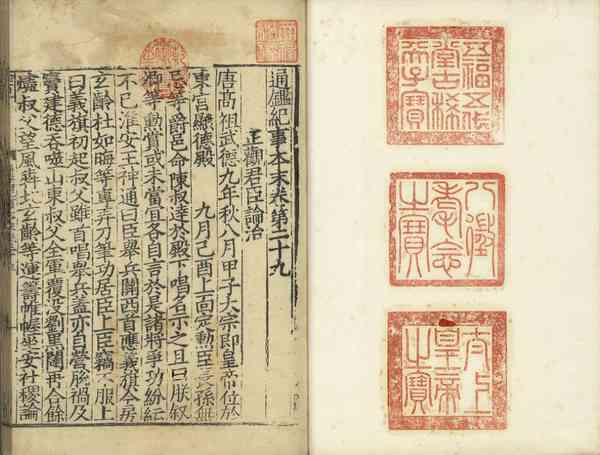
A page from the Comprehensive Mirror for Aid in Governance, a Narrative Edition by Yuan Shu
This period gave rise to many famous works and historians. Yuan Shu's (袁枢) Comprehensive Mirror for Aid in Governance, a Narrative Edition (《通鉴纪事本末》) was the first Chinese historical work to adopt the format of "ji shi ben mo" (纪事本末体, events, causes, and consequences), using the Zizhi Tongjian (《资治通鉴》, "Comprehensive Reflections to Aid in Governance") as its source material.
Zhu Xi (朱熹) was the consolidator of Neo-Confucianism, and the development of his philosophical system was accompanied by the intellectualization of historiography. The historiography of Zhu Xi became an integral part of the Neo-Confucian system. He devoted significant effort to historiography, producing works such as the Zizhi Tongjian Gangmu (《资治通鉴纲目》). While also based on the Zizhi Tongjian, this work created a new format of historical work known as the Gangmu style (纲目体, outline and details style), which had a significant impact on later historical works. In terms of thought, Zhu Xi disagreed with the vague orthodox concepts presented in Sima Guang's (司马光) Zizhi Tongjian. Instead, he emphasized the importance of orthodoxy and established a series of standards, which had a tremendous influence on later generations.
Religion
During the Southern Song period, aside from Islam, the main religious sects included Buddhism, Taoism, Shamanism (巫教), and various folk secret religions. At that time, the spread of Islam was still confined to the Arab and Persian Muslim communities in Guangdong (广东) and Fujian (福建), largely detached from the mainstream of Chinese religion.
Meanwhile, folk secret religions were classified by the Southern Song government as illegal cults, and in the early Southern Song period, they faced brutal suppression. Consequently, they were unable to form a large-scale presence.
Therefore, the mainstream religions in the Southern Song period were Buddhism, Taoism, and Shamanism.
Read More
History of Southern Song - External Threats and A Corner of Peace